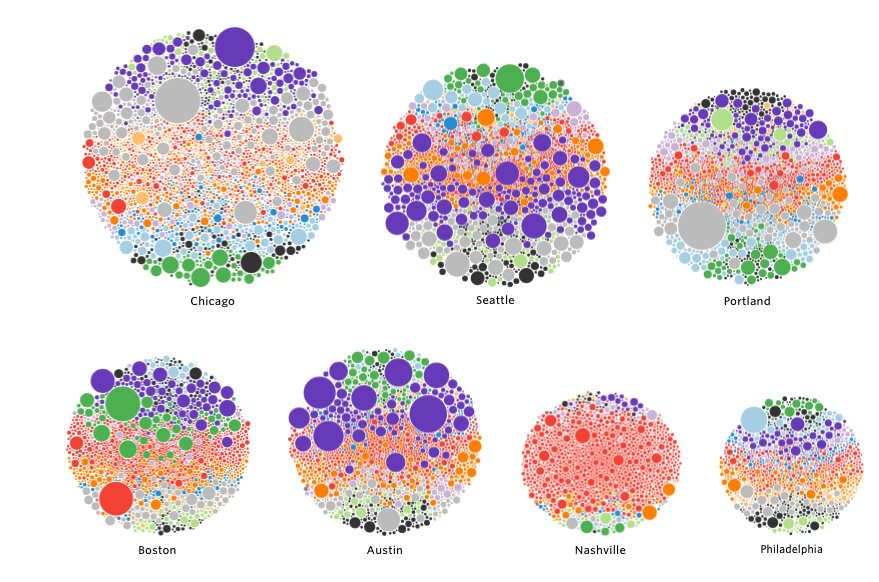What City Observatory did this week
1. America’s most creative metros, ranked by Kickstarter campaigns. One of the most popular ways to raise funds for a new creative project–music, a video, an artistic endeavor, or even a clever new product–is Kickstarter. Website Polygraph.cool has created an impressive visualization of nearly 100,000 kickstarter campaigns. We use that data to rank US metros by number of kickstarter campaigns per capita. The unsurprising leaders: Austin, Portland and San Francisco. See how your city compares, and use Polygraph’s data visualization to identify the top indie entrepreneurs in your area.

2. Successful cities and the civic commons. Cities are more than just collections of businesses, buildings and infrastructure: the social fabric of cities–they way they enable us to easily connect with one another–is important both to their economic function and to the civic realm. As we pointed out in our report Lost in Place, in many ways the social fabric of cities has been stressed and torn by growing segregation and privatization of many parts of our lives, from travel to entertainment to leisure. But there are growing signs of a revival of investments in the public realm that try to strengthen the social and civic functions of cities. Knight Foundation and others have launched a new initiative to reimagine the civic commons, with targeted funding for five cities around the country.
3. Caught in the prisoner’s dilemma of local planning. While the principle of local control has a lot of political resonance and popular support, when it comes to meeting our housing challenges, in creates a terrible conundrum. While every neighborhood in a city or metropolitan area would benefit from more affordable housing if greater density were more widely allowed, each individual neighborhood is reluctant to be the first (or only) place that allows more density, for fear that it alone will bear the brunt of change. This prisoner’s dilemma dominates many local zoning fights and is very much in evidence as New York tries to implement its new mandatory inclusionary zoning program.
4. Lessons in supply and demand: Housing Market edition. We recognize that many people bristle at the mention of economic terminology, but in our view its hard to make sense of our current housing affordability problems without explicitly thinking about supply and demand. Specifically, the demand for urban living has increased rapidly, and continues to do so; meanwhile the supply of great urban neighborhoods–and housing in those neighborhoods–has grown only slowly. The inevitable result is higher rents. Tackling our “shortage of cities” is a fundamental challenge.
This week’s must reads
1. Another NYC Affordable Housing Project gets shot down. In New York City, a proposal to build 209 units of affordable housing in Queens in an area currently zoned for manufacturing has apparently died, due to opposition by the local city councilor. As we’ve noted, the Achilles heel of Mayor de Blasio’s mandatory inclusionary zoning program is the need for project-by-project up-zonings. So far, in both of the cases that have come forward, the up-zonings have provoked neighborhood outcry, and led local city councilors to oppose the project, which given the City Council’s deference to issues in member’s own districts, is the kiss of death. Yet more evidence that hyper-localism in decision-making makes it extraordinarily difficult to tackle housing affordability.
2. The Jane Jacobs Centennial. Writing at the New Yorker, Adam Gopnick uses his review of two recently published biographies of Jane Jacobs to assess her contribution to our understanding of cities. He argues that some of her insights haven’t weathered the test of time well, but in many ways, her work continues to be as fresh and provocative as when she wrote it. And in important ways its prescient about the situation we now find ourselves in, as Gopnick notes: “The new crisis is the ironic triumph of Jacobs’s essential insight. People want to live in cities, and when cities are safe people do. Those with more money get more city than those with less.”
3. Bonus Must Watch: City Observatory’s Daniel Kay Hertz on Chicago Newsroom. You’ve read his commentaries here on City Observatory, now you can watch him on video as well, discussing a range of issues from urban sprawl, to changing demographics, and even optimal bus-boarding process (the latter really get him going). A full hour of urban wonkiness.

New knowledge
1. How zoning has re-shaped American cities. For decades, the conjecture among many academics was that zoning simply ratified the kinds of land use patterns that were already in place. But a new study of Chicago comparing land use patterns prior to the adoption of that city’s zoning code in 1923 with current development shows that zoning strongly influenced subsequent development. In a new NBER working paper, entitled Zoning and the Economic Geography of Cities, Allison Shertzer, Tate Tinam and Randall Walsh, examine parcel level data on land uses and market values from the 1920s and look to see how they are related to today’s development patterns. Their key findings: zoning does have an impact, and may be more influential in the location of different activities than either geography or transportation networks. They also find that exclusive residential zoning tends to drive up home prices. In addition, zoning seems to have greatly reduced mixed use development: in 1922, 82 percent of the developed blocks in Chicago had at least some commercial activity.
2. How city center service-exporting businesses drive the UK economy. A new report Trading places: Why firms locate where they do from the UK Centre for Cities looks at the location and growth of different industries. It divides businesses into those that export goods, those that export services and those that serve local demand. This is especially important for the service exporting sector which has powered the UK economy, as goods production as continued to decline. Fully 32 percent of Britain’s high-skilled jobs in service exports are located in city centers, more than double the proportion (14 percent) of all jobs. The report concludes with some pointed advice for new Prime Minister Theresa May: “The geography of Britain’s jobs and firms means that supporting growth in our cities will become increasingly important for improving the performance of the national economy.”
2. The 2016 Census Planning Database. The Census Bureau has released its annual compendium of geographically detailed data on population demographics and housing designed for use by planning technicians. This isn’t new information per se (the most recent data is taken from the 5-year American Community Survey results from 2010-2014). What it does do is assemble this information in a form–with census tract and block group estimates, and with baseline comparisons for similar geographies to Census 2010. Even by Census Bureau standards this is a giant mass of data; the national block group data is a 160 MB file.

